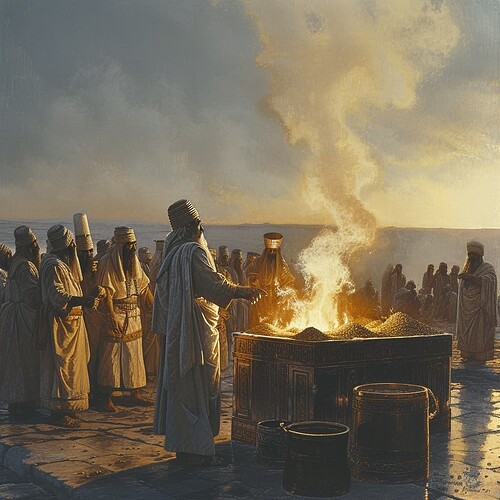![]() February 27: Leviticus 1, 2 - The Sacred Rituals Unveiled
February 27: Leviticus 1, 2 - The Sacred Rituals Unveiled
![]() Introduction
Introduction
Today, we venture into the book of Leviticus, chapters 1 and 2, where we explore the intricate details of the various offerings to the Lord, marking the core of ancient Israelite worship. Here, we see the importance of intentionality, precision and reverence in worshiping God.
![]() Leviticus 1: The Burnt Offering
Leviticus 1: The Burnt Offering
The text outlines the specifics for the burnt offering - a voluntary act of worship, signifying complete surrender to the Lord.
![]() Key Verse: Leviticus 1:4 - “He is to lay his hand on the head of the burnt offering, and it will be accepted on his behalf to make atonement for him.”
Key Verse: Leviticus 1:4 - “He is to lay his hand on the head of the burnt offering, and it will be accepted on his behalf to make atonement for him.”
![]() Leviticus 2: The Grain Offering
Leviticus 2: The Grain Offering
This chapter delves into the grain offering, hinting at the people’s gratitude and acknowledgment of God’s provision.
![]() Key Verse: Leviticus 2:13 - “Season all your grain offerings with salt. Do not leave the salt of the covenant of your God out of your grain offerings; add salt to all your offerings.”
Key Verse: Leviticus 2:13 - “Season all your grain offerings with salt. Do not leave the salt of the covenant of your God out of your grain offerings; add salt to all your offerings.”
![]() Key Themes and Reflections
Key Themes and Reflections
-
Prescribed Worship: Leviticus asserts God’s zeal for specific rituals. It suggests that worship isn’t just about our feelings—it involves order, decorum and obedience.
-
Symbols in Worship: The burnt and grain offerings respectively represent complete surrender and gratitude to God, highlighting the essence of worship.
![]() Today’s Application: These chapters invite us to examine our worship. Is it heartfelt, precise and reverent? Do we model the symbols of surrender and gratitude in our daily lives?
Today’s Application: These chapters invite us to examine our worship. Is it heartfelt, precise and reverent? Do we model the symbols of surrender and gratitude in our daily lives?
![]() Hidden Gem: The constant use of salt in the offerings signifies perpetuity, preservation and covenant loyalty.
Hidden Gem: The constant use of salt in the offerings signifies perpetuity, preservation and covenant loyalty.
![]() Reflective Q&A:
Reflective Q&A:
![]() Do the prescribed rituals in Leviticus have relevance today?
Do the prescribed rituals in Leviticus have relevance today?
A: Yes. Although we aren’t called to perform these exact rituals, they model the heart posture we should embody in worship—surrender and thankfulness.
![]() What does the constant use of salt signify?
What does the constant use of salt signify?
A: Salt denotes preservation, loyalty, and lasting covenant—a reminder of our ongoing, preserved devotion to God.
![]() Join the Discussion: What symbols of worship resonate with you, and how can they be applied in your life?
Join the Discussion: What symbols of worship resonate with you, and how can they be applied in your life?
![]() See You Tomorrow in Leviticus 3, 4:
See You Tomorrow in Leviticus 3, 4:
We’ll continue to dig into the complex offerings described in Leviticus, shedding light on their meanings and significance. Stay with us as we unravel these sacred scriptures one layer at a time.
